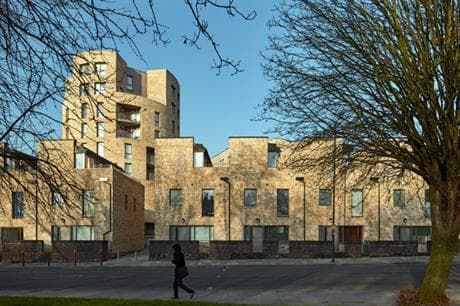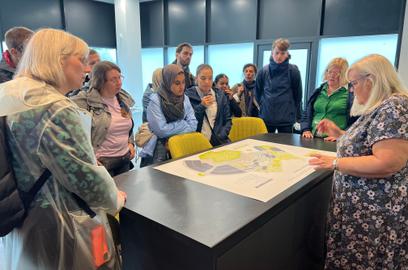Review: Redeveloping a London housing estate

Tibbalds
The Spring development that replaces part of the old Stonebridge Park estate fits well into its location and opens safe routes across the neighbourhood, find Julia Beyer and Ed Arthur.
The Spring development has arisen out of the urban fabric of the 1960s Stonebridge Park housing estate in north west London, connecting seamlessly with the surrounding regenerated areas of the old housing estate. Designed by architect Cullinan Studio for the housing association Hyde Group, the scheme was completed late last year and boasts 177 mid to high density units, wrapped around a communal waterside garden.
The high quality scheme provides a tenure mix comprising half homes for sale, and the rest is split between affordable rented and shared ownership. It is part of the £225 million regeneration project of the Stonebridge Park Estate in Harlesden that was started by the government sponsored housing action trust. Since the action trust was wound up in 2007, Brent Council has continued its work. The council’s regeneration strategy 2010-2030 identified Stonebridge Park as a priority area that would see the phased transformation of the 12.5 hectare estate.

Complementing its context
Cullinan Studio specified a single, warm coloured light brick, which is used throughout the development and helps tie its various components together. While Spring clearly has its own identity, the design approach has ensured that it is also complementary to its context and feels part of a larger tapestry. The southern edge of the site forms a strong frontage onto the busy Hillside road. The design is determined through a repetitive terraced typology that reflects the massing of the local area.
As a central plot within the redeveloped estate, the development provides a north-south connection from Hillside to Fawood Park and beyond. Fawood Park forms the boundary to the northern edge of Spring. This clean, open and public space is very well overlooked on three sides, and is constantly used by dog walkers and passers-by alike passing through the development to the nearby shops, community and health centres.
The internal areas are a key feature, providing the residents with an attractive environment. The spaces are bright, open and well overlooked, allow for parking away from the busy street, and serve as the main entrance to the homes lining the street. One of the development’s key features is the rotunda – a nine- storey cylindrical building which acts as a landmark for the surrounding area. It sits on the corner of the public open space, making the most of what was an awkward triangular plot. More centrally in the scheme is a shared semi-private space, which, with the building’s orientation, enjoys maximum sunlight. And an imaginative feature of the space is a diverted feeder canal that runs through the heart of the development.
Spring came out of a collaborative approach of community consultation and engagement, resulting in a successful space that is inclusive, well looked after and respected by its residents.
Perhaps most impressive of all is not the physical but the social change that has occurred here. Previously notorious for gang war and gun crime, the former Stonebridge Estate is now transformed – both spatially and socially. It serves not only as an attractive place to live and play, but as another monument to how good design and collaboration can change lives and liberate communities.
Ed Arthur and Julia Beyer are urban designers at planning and design consultancy Tibbalds Planning and Urban Design
Topics:
Related Updates

Medium density housing – how to deliver greater choice

Tibbalds

Oxford Study Trip

Tibbalds
Stay In Touch
Sign up to our Newsletter
Subscribe to our newsletter to receive updates about making people friendly places.

